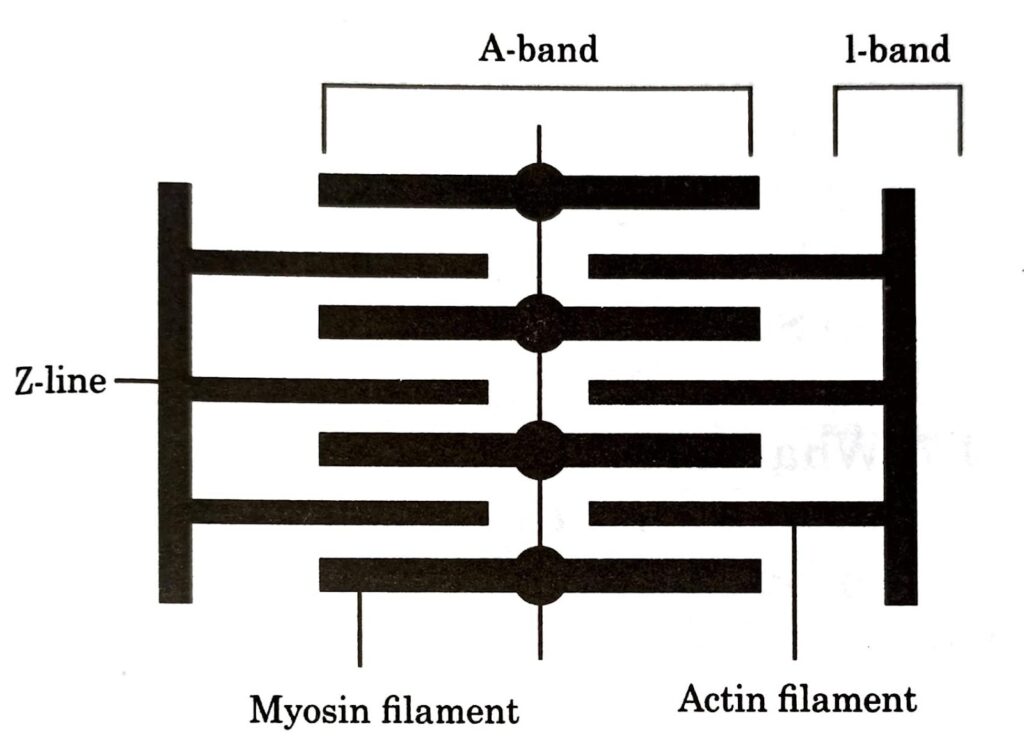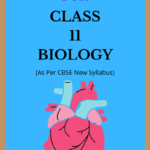NCERT Class 11 Biology Chapter 20 Locomotion Solutions to each chapter is provided in the list so that you can easily browse through different chapters NCERT Class 11 Biology Chapter 20 Locomotion and select need one. NCERT Class 11 Biology Chapter 20 Locomotion Question Answers Download PDF. NCERT Biology Class 11 Solutions.
NCERT Class 11 Biology Chapter 20 Locomotion
Also, you can read the NCERT book online in these sections Solutions by Expert Teachers as per Central Board of Secondary Education (CBSE) Book guidelines. CBSE Class 11 Biology Solutions are part of All Subject Solutions. Here we have given NCERT Class 11 Biology Chapter 20 Locomotion Notes, NCERT Class 11 Biology Textbook for All Chapters, You can practice these here.
Locomotion
Chapter: 20
BIOLOGY
TEXTUAL QUESTIONS ANSWERS
Q.1. Draw the diagram of a sarcomere of skeletal muscle showing different regions.
Ans. The diagram of a sarcomere:

Q.2. Define sliding filament theory of muscle contraction.
Ans. MECHANISM OF MUSCLE CONTRACTION:
(i) It is explained by SLIDING FILAMENT THEORY.
(ii) Muscle contraction occurs due to sliding of thin filaments over the thick filaments.
(iii) The sarcomere shortens because of the sliding of the thin myofilaments produced by cross bridge movements.
(iv) The sarcomere shortens but the lengths of thin and thick myofilaments do not change.
(v) H zone and I bands shorten but the width of A band remains constant.
Q.3. Describe the important steps in muscle contraction.
Ans. MECHANISM OF MUSCLE CONTRACTION:
(i) It is explained by SLIDING FILAMENT THEORY.
(ii) Muscle contraction occurs due to sliding of thin filaments over the thick filaments.
(iii) Nerve impulse reaches neuromuscu- lar junction and releases acetylcholine [Ach].
(iv) Ach creates active potential in the sarcolemma and stimulates the sarcoplasmic reticulum to release calcium ions into the sarcoplasm.
(v) The calcium ions bind to Troponin. Troponin binds to tropomyosin.
(vi) This shift exposes the active sites on the F actin molecules.
(vi) Using the energy from ATP hydrolysis, myosin head bind to exposed active sites on actin to form cross bridge.
(vii) The sarcomere shortens because of the sliding of the thin myofilaments produced by cross bridge movements.
(viii) The sarcomere shortens but the lengths of thin and thick myofilaments do not change.
(ix) H zone and I bands shorten but the width of A band remains constant.
Muscle Relaxation
(i) The calcium ions are quickly returned to sarcoplasmic reticulum by active transport. Troponin and tropomyosin molecules block the active sites on thin myofilaments.
(ii) Myosin cross bridges separate from actin.
(iii) When myosin cannot attach to actin, the muscle relaxes.
Q.4. Write true or false. If false change the statement so that it is true.
(a) Actin is present in thin filament.
Ans. True.
(b) H-zone of striated muscle fibre represents both thick and thin filaments.
Ans. False, H zone represents only thick filaments.
(c) Human skeleton has 206 bones.
Ans. True.
(d) There are 11 pairs of ribs in man.
Ans. False, 12 pairs of ribs.
(e) Sternum is present on the ventral side of the body.
Ans. True.
Q.5. Write the difference between:
(a) Actin and Myosin.
Ans. Actin and Myosin-
Myosin:
(i) Thick myofilaments are formed by myosin protein.
(ii) Myosin is made of two fragments: light meromyosin [LMM] & heavy meromyosin [HMM].
Actin:
(i) Thin Myofilaments is composed of three different proteins – actin, tro-pomyosin and troponin.
(ii) Actin occurs in two forms, the monomeric G actin and the polymeric F actin.
(b) Red and White muscles.
Ans. Red and White muscles:
| Red Muscle | White Muscle |
| These muscle fibres are dark red due to presence of red hemoprotein called myoglobin. | These muscles fibres are lighter in colour as they have very less quantity myoglobin. |
| Mitochondria are more in number. | Mitochondria are less in number. |
| They carry out considerable aerobic oxidation. | They depend mainly on anaerobic oxidation for energy production. |
(c) Pectoral and Pelvic girdle.
Ans. Pectoral and Pelvic girdle
PECTORAL GIRDLE
(i) It helps in articulation of upper limb with axial skeleton.
(ii) Each pectoral girdle consists of two bones Clavicle (collar bone) and Scapula
PELVIC GIRDLE
(i) It helps in articulation of lower limb with axial skeleton.
(ii) Pelvic girdle consists of two coxal / hip bones.
(iii) Each coxal bone is formed by three bones: ilium, ischium and pubis.
Q.6. Match Column I with Column II:
| Column I | Column II |
| (a) Smooth muscle | (i) Myoglobin |
| (b) Tropomyosin | (ii) Thin filament |
| (c) Red muscle | (iii) Sutures |
| (d) Skull | (iv) Involuntary |
Ans.
| Column I | Column II |
| (a) Smooth muscle | (iv) Involuntary |
| (b) Tropomyosin | (ii) Thin filament |
| (c) Red muscle | (i) Myoglobin |
| (d) Skull | (iii) Sutures |
Q.7. What are the different types of movements exhibited by the cells of human body?
Ans. The different types of movement exhibited by cells of the human body are:
(i) Amoeboid movement: Leucocytes show amoeboid movement.
(ii) Ciliary movement: sperms and ova show ciliary movement.
(iii) Muscular movement: Muscle cells show muscular movement.
Q.8. How do you distinguish between a skeletal muscle and a cardiac muscle?
Ans. SKELETAL MUSCLE:
(i) Striped / striated muscle with light and dark bands
(ii) Muscle fibres are cylindrical and un- branched
(iii) Muscle fibre is bound by external membrane called sarcolemma.
(iv) Muscle Fibres are multinucleated / syncytial in nature.
(v) Voluntary muscle (Nerve supply from central nervous system)
(vi) Involved in locomotory actions and body postures.
(vii) Skeletal muscle is surrounded by connective tissue sheath called epimysium.
(viii) Beneath the epimysium, skeletal muscle has bundles of individual muscle fibres called fascicles.
(ix) Each fascicle is surrounded by connective tissue sheath called perimysium.
(x) Each muscle fibre is surrounded by connective tissue sheath called endomysium.
CARDIAC MUSCLE:
(i) They are found in the wall of the heart – Myocardium.
(ii) Muscle fibres are cylindrical and branched.
(iii) Muscle fibres are uninucleate.
(iv) Muscle fibres bound by sarcolemma.
(v) Striated muscles with transverse faint dark and light bands.
(vi) They have Oblique bridges and in-tercalated discs at interval.
(vii) Involuntary muscles [Nerve supply from the central & autonomic nervous system].
(viii) Cardiac muscles are myogenic [con-tractions are generated within the muscles]
Q.9. Name the type of joint between the following:
(a) Atlas/axis.
Ans. Atlas/axis: Pivotal joint.
(b) Carpal/metacarpal of thumb.
Ans. Carpal/ metacarpal of thumb: Saddle joint.
(c) Between phalanges.
Ans. Between phalanges: Gliding joint.
(d) Femur/acetabulum.
Ans. Femur/acetabulum: Ball and socket joint.
(e) Between cranial bones.
Ans. Between cranial bones: Fibrous joint.
(f) Between pubic bones in the pelvic girdle.
Ans. Between pubic bones in the pelvic girdle: Ball and socket joint
Q.10. Fill in the blank spaces:
(i) All mammals have _____________ cervical vertebra.
Ans. 7.
(ii) The no of phalanges in each limb of human is _____________.
Ans. 14.
(iii) Thin filament of myofibril contains 2 Factions and two other proteins namely _____________.
Ans. Troponin, tropomyosin.
(iv) In a muscle fibre calcium is stored in _____________
Ans. Sarcoplasmic reticulum.
(v) _____________ and _____________ Pairs of ribs are called floating ribs.
Ans. 11, 12.
(vi) The human cranium is made of _____________ bones.
Ans. 8.

Hi! my Name is Parimal Roy. I have completed my Bachelor’s degree in Philosophy (B.A.) from Silapathar General College. Currently, I am working as an HR Manager at Dev Library. It is a website that provides study materials for students from Class 3 to 12, including SCERT and NCERT notes. It also offers resources for BA, B.Com, B.Sc, and Computer Science, along with postgraduate notes. Besides study materials, the website has novels, eBooks, health and finance articles, biographies, quotes, and more.




